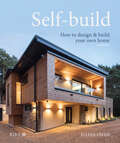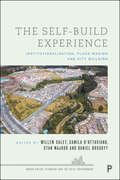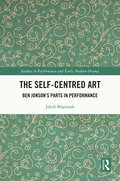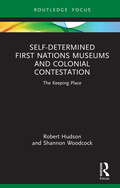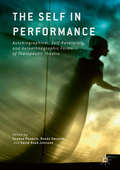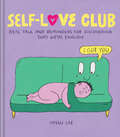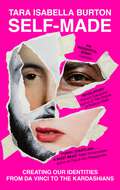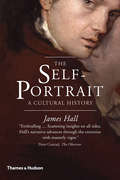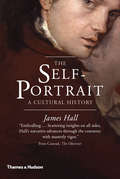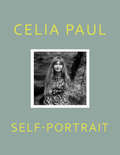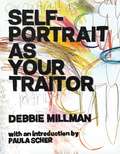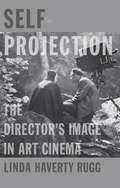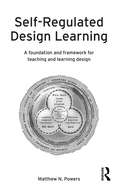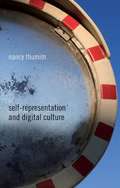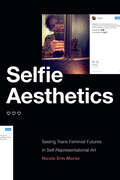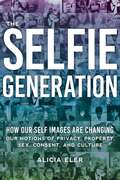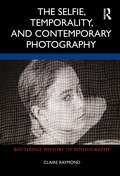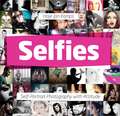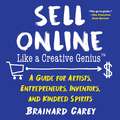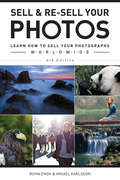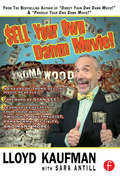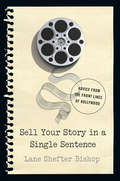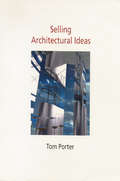- Table View
- List View
Self-build: How to design and build your own home
by Julian OwenIf you’ve ever dreamt of designing and building your own home, this book is for you. Becoming a ‘self-builder’ doesn’t necessarily mean learning to build a house physically from scratch. Anyone can be a self-builder – you can do so without ever having to lay a brick yourself. Self-built homes can also be more individual, better designed and more economical than buying from a developer. This book is designed for homeowners and self-builders, whether aspiring or on the brink of starting a project. It provides a jargon-free, step-by-step guide to the process of designing and building your own home, distilling all of the practical information needed to make your dream house a reality. Carefully crafted to offer friendly, easy-to-understand practical guidance and packed with watch points, hints and tips, it also highlights the potential pitfalls and suggests ways of avoiding them. Including indications of costs and timescales, Self-build demystifies the process of budgeting, finding a site, gaining planning permission, designing your home and all of the surrounding issues to do with sustainability, planning, regulations, procurement and the use of building contracts. Beautifully illustrated with over 230-colour photos, diagrams and plans, it provides all the inspiration and ideas you need to bring your own project to life. Featured houses include: Amphibious House by Baca Architects Corten Courtyard House by Barefoot Architects Haringey Brick House by Satish Jassal Architects Shawm House by Mawson Kerr Architects Sussex House by Wilkinson King Architects The Pocket House by Tikari Works Architects.
The Self-Build Experience: Institutionalization, Place-Making and City Building (Urban Policy, Planning and the Built Environment)
by Willem Salet, Camila D’Ottaviano, Stan Majoor and Daniël BossuytUsing a broad international comparative perspective spanning multiple countries across South America, Europe and Africa, contributors explore resident-led self-building for low and middle income groups in urban areas. Although social, economic and urban prosperity differs across these contexts, there exists a recurring, cross-continental, tension between formal governance and self-regulation. Contributors examine the multi-faceted regulation dilemmas of self-building under the conditions of modernization and consider alternative methods of institutionalization, place-making and urban design, reconceptualizing the moral and managerial ownership of the city. Innovative in scope, this book provides an array of globalized solutions for navigating regulatory tensions in order to optimize sustainable development for the future
The Self-Centred Art: Ben Jonson's Parts in Performance (Studies in Performance and Early Modern Drama)
by Jakub BoguszakThe Self-Centred Art is a study of the plays of Ben Jonson and the actors who first performed in them. Jakub Boguszak shows how the idiosyncrasies of Jonson’s comic characters were thrown into relief in actors’ part-scripts—scrolls containing a single actor’s lines and cues—some five hundred of which are reconstructed here from Jonson’s seventeen extant plays. Reading Jonson’s spectating parts, humorous parts, apprentice parts, and plotting parts, Boguszak argues that the kind of self-absorption which defines so many of Jonson’s famous comic creations would have come easily to actors relying on these documents. Jonson’s actors would have moreover worked on their cues, studied their speeches, and thought about the information excluded from their parts differently, depending on the type they had to play. Boguszak thus shows that Jonson brilliantly adapted his comedies to the way the actors worked, making the actors’ self-centredness serve his art. This book addresses Jonson’s dealings with the actors as well as the printers of his plays and supplements the discussion of different types of parts with a colourful range of case studies. In doing so, it presents a new way of understanding not just Ben Jonson, but early modern theatre at large.
Self-Determined First Nations Museums and Colonial Contestation: The Keeping Place (Museums in Focus)
by Robert Hudson Shannon WoodcockSelf-Determined First Nations Museums and Colonial Contestation explores Indigenous practices of curation, object repatriation, and cross-cultural community engagement in a dynamic Koori museum. Grounded in the fact that Gunai Kurnai people have never ceded sovereignty, the text reorients dominant temporal and colonial approaches of museum studies to document and theorise Gunai Kurnai self-presentation and community engagement in the Krowathunkooloong Keeping Place. Researched and co-authored by the Cultural Manager of the Keeping Place, Gunai Kurnai Monero Ngarigo man Robert Hudson, and white Historian Shannon Woodcock, the book traces the temporal, social, and cultural considerations of the Elders who curated the permanent exhibition in the early 1990s. Discussing community management of a collection growing through the ongoing repatriation of tools, art, and Ancestor remains, the text also explores how Robert Hudson engages with visitors to the Keeping Place and local colonial history museums, and theorises the power of Gunai Kurnai work with individuals and institutions in the small museum context. Finally, Hudson and Woodcock demonstrate that the Keeping Place articulates sophisticated Gunai Kurnai-grounded methodologies of museum practice in relation to international critical Indigenous studies scholarship. Self-Determined First Nations Museums and Colonial Contestation provides a vital case study of an Indigenous museum space written from an inside perspective. As such, the book will be essential reading for scholars and students engaged in the study of museums and heritage, Indigenous peoples, decolonisation, race, anthropology, culture, and history.
The Self in Performance: Autobiographical, Self-Revelatory, and Autoethnographic Forms of Therapeutic Theatre
by Susana Pendzik, Renée Emunah and David Read JohnsonThis book is the first to examine the performance of autobiographical material as a theatrical form, a research subject, and a therapeutic method. Contextualizing personal performance within psychological and theatrical paradigms, the book identifies and explores core concepts, such as the function of the director/therapist throughout the creative process, the role of the audience, and the dramaturgy involved in constructing such performances. It thus provides insights into a range of Autobiographic Therapeutic Performance forms, including Self-Revelatory and Autoethnographic Performance. Addressing issues of identity, memory, authenticity, self-reflection, self-indulgence, and embodied self-representation, the book presents, with both breadth and depth, a look at this fascinating field, gathering contributions by notable professionals around the world. Methods and approaches are illustrated with case examples that range from clients in private practice in California, through students in drama therapy training in the UK, to inmates in Lebanese prisons.
Self-Love Club: Real Talk and Reminders for Discovering that We're Enough
by Hyesu LeeThis celebration of self‑love and healing, from illustrator and comics creator Hyesu Lee, is a knowing smile and a shared sigh in book form. Welcome to the club!Finding the uniqueness that makes you you. Empowering yourself while staying vulnerable and open. Learning to rest, nurture your needs, and embrace self-love. Hyesu Lee has been on a healing journey toward all these states, and she invites you to come along with her.In this generously candid compilation of art, comics, and illustrated reflections, Lee shines a humorous and heartfelt light on the small moments in life that help us find ourselves and learn to love what we find. This charming little book makes the perfect gift for that person in your life you'd like to see join the self‑love club, whether that's a friend, a loved one, or your very own self.A POSITIVE APPROACH TO SELF-CARE: This book takes a joyous approach to self-acceptance and is full of reminders that no matter where you are in your journey, you are enough, and you are loved. Its humor and bright colors make it a breath of fresh air, but it's also not afraid to look at the harder things in life. We must love ourselves in good times and in bad, and small encouragements like this comic gem are just what we need to help us do so. RISING-STAR ARTIST: Hyesu Lee's work as a muralist, illustrator, and cartoonist inspires her fans with its unique take on life. Born and raised in Seoul, South Korea, she is now based in Brooklyn and has gained a loyal following for her idiosyncratic style found in illustrations for brands, magazines, public murals, and packaging worldwide.CONTENT-RICH GIFT BOOK: While this book is petite and sweetly sized for gifting, it's chock-full of words of wisdom and clever reflections to peruse over and over. This is a book to spend time with or to keep at the bedside whenever you need to feel seen.Perfect for:Anyone who could use a boost to their mental health and own sense of self-loveGiving as girlfriend gifts, gifts of encouragement, or Valentine's Day giftsFans of Hyesu LeeIllustration buffsReaders of comics and graphic novels from artists like Allie Brosh, Abbi Jacobson, Reza Farazmand, and Ton Mak
Self-Made: Creating Our Identities from Da Vinci to the Kardashians
by Tara Isabella Burton'We're all now self-makers, whether we like it or not - and this witty, sceptical book is the thought-provoking story of how we got here' GUARDIAN'This funny, startling, insightful story of the selfie, from Dürer to the Kardashians, is a must read if you want to understand how we reinvent ourselves every time we reveal ourselves' PETER POMERANTSEVToday's defining celebrities have crafted public personae that walk the tightrope between authenticity and artificiality. Ordinary people now follow suit: lovingly tending our 'personal brands' for economic gain and self-expression alike.Instagram culture is part of a story that goes back centuries. The vision that we not only can but should 'make' our own selves to shape our own destiny is an inextricable part of the formation of the modern world.As traditional powers of pre-modernity - church and throne - waned, a new myth took their place: that of the 'self-made man', whose unique powers of personality - or canny self-presentation - give him not just the opportunity, but the obligation, to remake reality in the image of what he wants it to be.From the Renaissance genius to the Regency dandy, the American prophets of capitalism to the aspirational übermensch of European fascism, Hollywood's Golden Age to today's Silicon Valley, Self-Made takes us on a dazzling tour of modern history's most prominent self-makers, uncovering both self-making's liberatory power, and the dangers this idea can unleash.'Both revelatory and a warning about the ways that focus on the self distorts our individual lives and the broader society' FRANCIS FUKUYAMA
The Self-Portrait: A Cultural History
by James HallSheds new light on the long history of self-portraiture with fresh interpretations of famous examples and new works, ideas, and anecdotes This broad cultural history of self-portraiture brilliantly maps the history of the genre, from the earliest myths of Narcissus and the Christian tradition of "bearing witness" to the prolific self-image-making of today's contemporary artists. Focusing on a perennially popular subject, the book tells the vivid history of works that offer insights into artists' personal, psychological, and creative worlds. Topics include the importance of the medieval mirror craze in early self-portraiture; the confessional self-portraits of Titian and Michelangelo; the mystique of the artist's studio, from Vermeer to Velázquez; the role of biography and geography for serial self-portraitists such as Courbet and Van Gogh; the multiple selves of modern and contemporary artists such as Cahun and Sherman; and recent developments in the era of globalization. Comprehensive and beautifully illustrated, the book features the work of a wide range of artists including Beckmann, Caravaggio, Dürer, Gentileschi, Ghiberti, Giotto, Goya, Kahlo, Kauffman, Magritte, Mantegna, Picasso, Poussin, Raphael, Rembrandt and Van Eyck. The full range of the subject is explored, including comic and caricature self-portraits, "invented" or imaginary self-portraits, and important collections of self-portraiture such as that of the Medici.
The Self-Portrait: A Cultural History
by James Hall“Hall provides a lively cultural interpretation of the genre from the Middle Ages to today. . . . Rather than provide a series of ‘greatest hits,’ he is more concerned with the reasons why artists create self-portraits.” —The Weekly Standard The self-portrait may be the visual genre most identified with our confessional era, but modern artists are far from the first to have explored its power and potential. In this broad cultural survey of the genre, art historian and critic James Hall brilliantly maps the history of self-portraiture, from the earliest myths of Narcissus and the Christian tradition of “bearing witness” to the prolific self-image-making of today’s contemporary artists. Hall’s intelligent and vivid account shows how artists’ depictions of themselves have been part of a continuing tradition that reaches back centuries. Along the way he reveals the importance of the medieval mirror craze; the explosion of the genre during the Renaissance; the confessional self-portraits of Titian and Michelangelo; the biographical role of serial self-portraits by artists such as Courbet and van Gogh; themes of sex and genius in works by Munch, Bonnard, and Modersohn-Becker; and the latest developments of the genre in the era of globalization. Comprehensive and beautifully illustrated, the book features the work of a wide range of artists including Alberti, Caravaggio, Dürer, Emin, Gauguin, Giotto, Goya, Kahlo, Koons, Magritte, Mantegna, Picasso, Raphael, Rembrandt, and Warhol.
Self-Portrait
by Celia PaulA rich, penetrating memoir about the author's relationship with a flawed but influential figure--the painter Lucian Freud--and the satisfactions and struggles of a life lived through art.One of Britain's most important contemporary painters, Celia Paul has written a reflective, intimate memoir of her life as an artist. Self-Portrait tells the artist's story in her own words, drawn from early journal entries as well as memory, of her childhood in India and her days as a art student at London's Slade School of Fine Art; of her intense decades-long relationship with the older esteemed painter Lucian Freud and the birth of their son; of the challenges of motherhood, the unresolvable conflict between caring for a child and remaining commited to art; of the "invisible skeins between people," the profound familial connections Paul communicates through her paintings of her mother and sisters; and finally, of the mystical presence in her own solitary vision of the world around her. With over seventy illustrations, Self-Portrait is a powerful, liberating evocation of a life and of a life-long dedication to art.
Self Portrait as Your Traitor
by Debbie MillmanDebbie Millman's illustrated essays and visual poems are part philosophy, part art, part deeply personal memoir exposing the universal triumphs and tribulations of being human. Her hand-lettered typography - sometimes tender, sometimes gritty, always breathtaking in its visceral candor - makes Self Portrait as Your Traitor a moving masterpiece of a singular art form that speaks to our deepest longings for beauty, honesty, and the ineffable magic of what it means to live.
Self-Projection
by Linda Haverty RuggIn 1957, a decade before Roland Barthes announced the death of the author, François Truffaut called for a new era in which films would "resemble the person who made" them and be "even more personal" than an autobiographical novel. More than five decades on, it seems that Barthes has won the argument when it comes to most film critics. The cinematic author, we are told, has been dead for a long time. Yet Linda Haverty Rugg contends not only that the art cinema auteur never died, but that the films of some of the most important auteurs are intensely, if complexly, related to the lives and self-images of their directors. Self-Projection explores how nondocumentary narrative art films create alternative forms of collaborative self-representation and selfhood.The book examines the work of celebrated directors who plant autobiographical traces in their films, including Truffaut, Bergman, Fellini, Tarkovsky, Herzog, Allen, Almodóvar, and von Trier. It is not simply that these directors, and many others like them, make autobiographical references or occasionally appear in their films, but that they tie their films to their life stories and communicate that link to their audiences. Projecting a new kind of selfhood, these directors encourage identifications between themselves and their work even as they disavow such connections. And because of the collaborative and technological nature of filmmaking, the director's self-projection involves actors, audience, and the machines and institution of the cinema as well.Lively and accessible, Self-Projection sheds new light on the films of these iconic directors and on art cinema in general, ultimately showing how film can transform not only the autobiographical act but what it means to have a self.
Self-Regulated Design Learning: A Foundation and Framework for Teaching and Learning Design
by Matthew N. PowersSelf-Regulated Design Learning: A Foundation and Framework for Teaching and Learning Design reframes how educators in architecture, landscape architecture, and other design disciplines think about teaching and learning design. The book weaves together concepts of constructivism, social cognitive theory, and self-regulated learning into a solid theoretical foundation for innovative teaching that emphasizes meaning, memory, problem solving, and mastery. The central goal of self-regulated design learning is making design learnable so that students are encouraged to become active, engaged participants in the design learning process. Key features of the book include: examining the issues, values, and challenges of teaching and learning in design, exploring select educational theories and concepts relevant to design pedagogy, illustrating the pivotal relationships between design learning and self-regulation, and discussing pedagogic techniques that support self-regulated design learning and lead to greater student achievement and performance. Self-Regulated Design Learning: A Foundation and Framework for Teaching and Learning Design provides numerous examples and applications to help design educators understand how to implement the self-regulated design learning methodology in their studios. Through this book, design educators will discover new ways of encouraging meaningful design learning through an advanced approach that is empowering, inspiring, and vital.
Self-Representation and Digital Culture
by Nancy ThumimTaking a close look at ordinary people 'telling their own story', Thumim explores self-representations in contemporary digital culture in settings as diverse as reality TV, online storytelling, and oral histories displayed in museums. Now available in paperback, Self-Representation and Digital Culture addresses the institutional contexts of production, technology and form of the texts, and the point of view of those who represent themselves. This highly original research examines how contradictory and widely different politics inform and shape examples of 'speaking for oneself'. In the book, Thumim argues that analysis and theorization of the activity of self-representation is vital for media, communication and cultural studies at a time when examples, of what should now be understood as a genre, both surround us and appear, at first glance, to all be alike.
The Self-Sufficient Home: Going Green and Saving Money
by Christopher NyergesHow to cut heating and cooling costs, utilize solar energy, construct nonflush toilets and solar showers, collect rainwater, and apply permaculture techniques. The author explains everything in plain, easily understood, language with hundreds of photographs and diagrams that illustrate ways to use natural resources and embrace self-reliance. Sustainable living advice from self-reliance expert Christopher Nyerges, editor of "Wilderness Way" magazine and author of "How to Survive Anywhere."In an ever-changing economy, cutting costs and utilizing available resources is essential. From embracing solar energy and wind power to using fluorescent bulbs and growing backyard vegetable gardens, there are endless ways to live a more ecological and economical lifestyle. The book offers a collection of testimonials and hordes of practical information on living lightly on the planet.
Selfie Aesthetics: Seeing Trans Feminist Futures in Self-Representational Art
by Nicole Erin MorseIn Selfie Aesthetics Nicole Erin Morse examines how trans feminine artists use selfies and self-representational art to explore transition, selfhood, and relationality. Morse contends that rather than being understood as shallow emblems of a narcissistic age, selfies can produce politically meaningful encounters between creators and viewers. Through close readings of selfies and other digital artworks by trans feminist artists, Morse details a set of formal strategies they call selfie aesthetics: doubling, improvisation, seriality, and nonlinear temporality. Morse traces these strategies in the work of Zackary Drucker, Vivek Shraya, Tourmaline, Alok Vaid-Menon, Zinnia Jones, and Natalie Wynn, showing how these artists present improvisational identities and new modes of performative resistance by conveying the materialities of trans life. Morse shows how the interaction between selfie creators and viewers constructs collective modes of being and belonging in ways that envision trans feminist futures. By demonstrating the aesthetic depth and political potential of selfie creation, distribution, and reception, Morse deepens understandings of gender performativity and trans experience.
The Selfie Generation: How Our Self-Images Are Changing Our Notions of Privacy, Sex, Consent, and Culture
by Alicia Eler<p>Whether it's Kim Kardashian uploading picture after picture to Instagram or your roommate posting a mid-vacation shot to Facebook, selfies receive mixed reactions. But are selfies more than, as many critics lament, a symptom of a self-absorbed generation? <p>Millennial Alicia Eler's The Selfie Generation is the first book to delve fully into this ubiquitous and much-maligned part of social media, including why people take them in the first place and the ways they can change how we see ourselves. Eler argues that selfies are just one facet of how we can use digital media to create a personal brand in the modern age. More than just a picture, they are an important part of how we live today. <p>Eler examines all aspects of selfies, online social networks, and the generation that has grown up with them. She looks at how the boundaries between people’s physical and digital lives have blurred with social media; she explores questions of privacy, consent, ownership, and authenticity; and she points out important issues of sexism and double standards wherein women are encouraged to take them but then become subject to criticism and judgment. Alicia discusses the selfie as a paradox—both an image with potential for self-empowerment, yet also a symbol of complacency within surveillance culture The Selfie Generation explores just how much social media has changed the ways that people connect, communicate, and present themselves to the world.</p>
The Selfie, Temporality, and Contemporary Photography (Routledge History of Photography)
by Claire RaymondThis book is a theoretical examination of the relationship between the face, identity, photography, and temporality, focusing on the temporal episteme of selfie practice. Claire Raymond investigates how the selfie’s involvement with time and self emerges from capitalist ideologies of identity and time. The book leverages theories from Katharina Pistor, Jacques Lacan, Rögnvaldur Ingthorsson, and Hans Belting to explore the ways in which the selfie imposes a dominant ideology on subjectivity by manipulating the affect of time. The selfie is understood in contrast to the self-portrait. Artists discussed include James Tylor, Shelley Niro, Ellen Carey, Graham MacIndoe, and LaToya Ruby Frazier. The book will be of interest to scholars working in visual culture, history of photography, and critical theory. It will also appeal to scholars of philosophy and, in particular, of the intersection of aesthetic theory and theories of ontology, epistemology, and temporality.
The Selfie, Temporality, and Contemporary Photography (Routledge History of Photography)
by Claire RaymondThis book is a theoretical examination of the relationship between the face, identity, photography, and temporality, focusing on the temporal episteme of selfie practice.Claire Raymond investigates how the selfie’s involvement with time and self emerges from capitalist ideologies of identity and time. The book leverages theories from Katharina Pistor, Jacques Lacan, Rögnvaldur Ingthorsson, and Hans Belting to explore the ways in which the selfie imposes a dominant ideology on subjectivity by manipulating the affect of time. The selfie is understood in contrast to the self-portrait. Artists discussed include James Tylor, Shelley Niro, Ellen Carey, Graham MacIndoe, and LaToya Ruby Frazier.The book will be of interest to scholars working in visual culture, history of photography, and critical theory. It will also appeal to scholars of philosophy and, in particular, of the intersection of aesthetic theory and theories of ontology, epistemology, and temporality.
Selfies: Self-Portrait Photography with Attitude
by Haje Jan KampsSelfies by Haje Jan Kamps is ultimately a celebration of the culture of social networking, the world where you aren't anybody until you have a photo of yourself, and what that photo says is critically important. <P><P>Whether you're an artist soul, or you want to show your smoldering hot side, this cheeky, sexy, and loud book will show you how to depict these parts of you through photography.With pictures and stories from the best of the best, gather tips for photographing yourself and learn how to take selfies.Learn how to portray innocence and drama, tell stories with your photo, use costumes and props during your shoot, shoot on location or in action, and much more. <P>Gather the photography skills you need to capture the look you want, and learn how to edit your photos after the shoot to add layers, highlights, and more.In Selfies you'll find:11 chapters filled with photography editing tips to help ease clarify the process of taking selfiesAdvice for using mobile apps utilizing other techniques to perfect your picturesA plethora of visual examples to clarify techniques ideas presented in the book
Sell Online Like a Creative Genius: A Guide for Artists, Entrepreneurs, Inventors, and Kindred Spirits (Like a Creative Genius #1)
by Brainard CareyHow to sell art or anything else online without leaving your home. Whether you’re selling original artwork, jewelry, or a unique product, this is the book for you. Brainard Carey offers advice with solid examples of how building an online business is something every creative person can pursue. Carey draws from his extensive experience and interviews with others to show artists and creative people how to sell their work independently and efficiently. Readers will learn how to establish an online store, develop a presence, promote their goods, and reach customers. Chapter topics include: Designing a website or profile on an existing site Effective marketing strategies Creative ways to advertise your product Building your social media following Finding new customers Real examples of artists and entrepreneurs who succeeded in selling their work online And much more With chapters divided between practical how-tos and case studies, Sell Online Like a Creative Genius™, offers readers both instructive and demonstrative lessons in making their small online business a reality. Everyone can do it with the right tools, and Carey offers an insider’s guide to an otherwise daunting process.
Sell & Re-Sell Your Photos: Learn How to Sell Your Photographs Worldwide
by Rohn Engh Mikael KarlssonSell your photos again and again! Live anywhere. Pick your hours. Be your own boss. Earn more money. See your pictures in print. Discover the freedom of a profitable photo business by learning the secrets behind making and selling editorial stock photography. For more than three decades, industry classic Sell & Re-Sell Your Photos has been giving new and veteran photographers the tools to sell their pictures consistently to markets they enjoy. Rohn Engh's master text, with updates from independent photographer Mikael Karlsson, outlines the time-tested formula for successfully marketing your work to publishers world-wide. This completely revised and expanded 6th edition features up-to-date advice, brand new photos and charts and tables to help you achieve your goals. Learn how to:Create enduring images--the ones photo buyers always needPrice your photos like a professionalFind your niche and corner that marketTake and market your work with modern technologyConfidently submit to agencies and publishersDigitally store your archiveProtect yourself and your photos with basic copyright laws and regulationsIncludes a detailed five-week action plan to get you organized and sellingMaster the stock photography market: Take pictures today that you can sell for many tomorrows to come!
Sell Your Own Damn Movie!
by Lloyd KaufmanThis is the 3rd volume in Mr. Kaufman's hilarious, how-to series for hard-working self-starters and hard-laughing, cheeky filmmakers. "Sell Your Own Damn Movie!" covers everything you need to do to get your finished film seen by festival-goers, movie-goers, DVD-buyers and web-goers around the world. You will be lead through a primer on the history of film distribution to a discussion of the many ways you can get your film out there, either through a reputable distributor or all on your own. From the realities of distribution, to utilizing the internet to self-distribution, Mr. Kaufman tells you in his habitually lucid and off-the-wall way. Inserts include interviews and pointers from veteran distribution pros as well as directors and producers who share their own front-line stories. Mr. Kaufman recounts his own raucous stories of marketing pleasures and nightmares from 35 years of movie-making experience, creating a uniquely useful and entertaining read. Or, in Lloyd's inimitable words. The most asked question at my worldwide popular, legendary, renowned master class is, "How do I get my no-budget, zombie giraffe flick distributed?†Well, have no fear, because the 3rd volume in Uncle Lloydie's how-to series of go-to guides for filmmakers reveals the secrets, methods and tricks (short of prostituting yourself and selling bodily organs) to getting your film distributed. With Troma, our legendary 35-year-old independent studio, Michael Herz and I have developed a low cost, high-impact method for low-budget film distribution, which has lead to a high-profile brand name and a catalog of over 800 titles! Now you can learn to get you movie out there, too. I will be your busty tour guide, sharing with you my hard-earned cinematic distribution know-how! -LEARN! How I achieved box office success with my fowl chicken zombie masterpiece Poultrygeist, and everyone's favorite super-human hero from New Jersey, the Toxic Avenger, for practically no money! -SMELL! The sewer that is mainstream distribution as I drag you through the muck, be-farting upon you the real scoop behind "indie†and mainstream distribution deals. -MASTICATE! (No, not that kind of masticating) On the knowledge of DVD distribution as I es-chew the fat and get to the skinny of Do-It-Yourself DVD distribution. I will teach you the fundamentals of having a good website (like www.Troma.com) to boost your sales! -FEAST! On my golden brown chicken puns as I cleverly cluck your brain out with the irrefutable knowledge of how I sold over 10,000 units of the 3-disc limited-edition Poultrygeist DVD in a matter of months! YES! If you have any doubt that I will not be able turn your no-budget zombie giraffe opus into box-office gold, then put down this book proposal! No wait, pick it back up, pick it back up! This is a recession damnit, Troma needs all the money we can, er... I need to educate you filmmakers looking for distribution gold (brown)! After reading my book, any damn filmmaker will be able to "Sell Your Own Damn Movie!†Featuring expert advice from those who have successfully sold their films: * David Cronenberg (Director of The Fly, Crash, A History of Violence)* Oren Peli (Director/Producer of Paranormal Activity)* Ted Hope (Producer of Crouching Tiger, Hidden Dragon, In the Bedroom, Happiness)* Brad Kembel (Executive Vice President of International Distribution at Summit Films; Twilight)* James Gunn (Writer/Director of Super, Dawn of the Dead, Slither)* Jonathan Wolf (Executive Vice President, Independent Film and Television Alliance and Managing Director, American Film Market)... and many more who have sold their own damn movies!
Sell Your Story in A Single Sentence: Advice from the Front Lines of Hollywood
by Lane Shefter BishopEvery writing project has one thing in common--they all start with a single sentence. Writers constantly struggle to answer this question: What is your story about? Finally, a guide by a leading Hollywood insider who actually knows the answer--and now she shows you how to do it yourself! Lane Shefter Bishop, CEO of Vast Entertainment, explains the key to selling your screenplay, novel, or script. This comprehensive guide to opening career doors is the first of its kind, highlighting the tips and techniques for making your story stand out. From tips on character development to hints on points to avoid, Bishop covers all your bases when selling your story.
Selling Architectural Ideas
by Tom PorterAs 'visual animals' architects continue to live and work in a pictorial age in which image-making remains the central activity of environmental design. Selling Architectural Ideas explores the promotional role of architectural graphics and drawing at the point of communication, i.e. at their point of sale. By substituting the words 'communication' and 'presentation' with the word 'selling' we confront the reality of a highly competitive world in which the process of creating images for selling architectural ideas is approached as a more persuasive and, therefore, more successful design tool.
